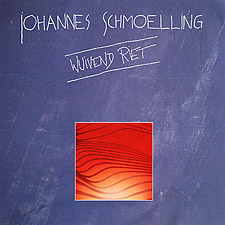 (D) 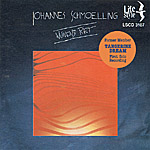 alternate cover (US) 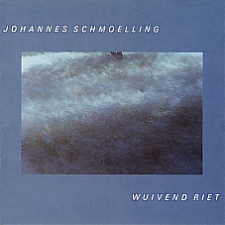 alternate cover (JP) |
Wuivend Riet 1986, LP: Erdenklang IRS 942.160 1987, CD: Erdenklang IRS 971.160, US-CD: Lifestyle LSCD 3107 21th Oct. 1988, J-CD: Erdenklang/ Imagine Music A32C-71 „Wuivend Riet" comes from the Dutch and means „wind blown reeds". „Wuivend Riet" ist niederländisch und heißt „Wehendes Schilf". read a very current review about Wuivend Riet in french: click here (added August 23, 2006)
All tracks composed, performed, produced and mixed by JOHANNES SCHMOELLING at Riet-Studio, Berlin 1986 Keyboards, computer programming and electronic percussion by JOHANNES SCHMOELLING The Voice: HANS BOSCH |
||||||||||||||||||
| »concerning the music« People might be inclined to categorise »Wuivend Riet«, Johannes Schmoelling's first solo project, as electronic music. In so far as this tag names the media employed, that is correct. Over and above this, however, such a characteristic of this music's individuality applies only out wardly, while basically concealing instead of stating something conclusive about it. In actual fact, a major impulse of this music is that it strictly rejects the conventional, which in turn also means the convenience of electronic music. That in this instance Johannes Schmoelling should even use the most advanced technology is not necessarily a contradiction by any means. It rather indicates that he derives his musical creed precisely from the inner tension relationship. »Wuivend Riet« is an attempt to surmount the mere electronic element and to arrive at a different musically inspired attitude towards electronics and their possibilities. In Johannes Schmoelling's case it is not a mass of machinery that dominates the scene, but solely the musical consideration, the shape. In place of the monochromes, slow-motion style (like, for instance, »sphere tone«, it has to a certain degree become the synonym for electronic boredom), a dynamic and occasionally even a dramatic impetus predominates. The tonal space begins to move, the tonal surfaces are in motion like adjustable walls - so that in the tonal sector too an impression arises as if faced by a stage set, apparently continually changing of its own volition, bringing forth from the ever constant the ever new. The title track was originally composed as theatre music - for the play »Opus ESP« by Hans Bosch, which had its premiere 1985 in Amsterdam. The play's final scene shows human figures hanging on super-dimensional, super-human sized reeds - people swaying to and fro among the reeds. To this stage backdrop, »Wuivend Riet« tells of nothing but the rhythm of time, the passing of the hour, the mood of the light. Of now a day runs its course. The simplest of all the most mysterious stories ever told. »Wuivend Riet« - Parts I and II - is programme music. Far more strongly than in the other, the »more easily assimilated« pieces of this record, the natural sounds are here an integral component of the composition. At the same time it is not a matter of using a nature quotation to awaken the illusion of idyll, but exclusively in the musical structure of the natural sound, in the question of how it can be combined with the electronically created tone picture and even the formative element. The answer is the endeavour to combine that which in reality strangely and irreconcilably confronts itself as second nature, as music. © Martin Burckhardt translated by Frederick A. Bishop |
»Über die Musik« Man mag „Wuivend Riet“, Johannes Schmoellings erstes Solo-Projekt, der elektronischen Musik zurechnen - und insofern dieses Etikett die eingesetzten Mittel benennt, ist dies zutreffend. Darüber hinaus jedoch bleibt eine solche Charakteristik der Eigenart dieser Musik nur äußerlich, verdeckt sie im Grunde mehr als daß sie etwas Schlüssiges über sie aussagt. Tatsächlich ist ein nicht unwesentlicher Impuls dieser Musik, daß sie sich den Konventionen, und das heißt auch: den Bequemlichkeiten der elektronischen Musik streng versagt. Daß Johannes Schmoelling sich dabei selbst der avanciertesten Technik bedient, muß gar kein Widerspruch sein. Vielmehr läßt sich gerade aus diesem inneren Spannungsverhältnis sein musikalisches Credo herleiten. „Wuivend Riet“, das ist der Versuch, das bloß Elektronische zu überwinden und zu einer anderen, musikalisch inspirierten Auffassung der Elektronik und ihrer Möglichkeiten zu gelangen. Nicht der Maschinenpark beherrscht bei Johannes Schmoelling die Szene, sondern allein die musikalische Erwägung, die Form. Anstelle des Monochromen, Zeitlupenartigen (wie es als »Sphärenklang« gewissermaßen zum Synonym für elektronische Langeweile geworden ist) dominiert ein dynamisches, ja bisweilen gar theatralisches Moment. Der Klangraum gerät in Bewegung, die Klangflächen beginnen sich verschiebbaren Wänden gleich zu bewegen - so daß auch im Klanglichen ein Eindruck entsteht wie angesichts eines Bühnenbildes, das sich wie von selbst unablässig verändert, ein Raum, der aus dem Immergleichen das Immerneue hervorbringt. Nicht von ungefähr ist der Titeltrack „Wuivend Riet“ ursprünglich als Theatermusik entstanden - für das Stück „Opus ESP“ von Hans Bosch, das 1985 in Amsterdam uraufgeführt wurde. Im Schlußbild des Stückes waren zu sehen: Menschenleiber, an überdimensionierten, übermenschlichen großen Schilfhalmen hängend. Menschen im Schilf, schwankend. Vor diesem Bühnenprospekt nun erzählt „Wuivend Riet“ von nichts anderem als vom Rhythmus der Zeit, dem Wechsel der Stunde, der Stimmung des Lichts. Wie ein Tag verstreicht. Von der allereinfachsten, allerrätselhaftesten aller Geschichten. „Wuivend Riet“ - Part I und II - ist eine Programmusik. Und also: programmatisch zu nennen. Weit stärker als in den übrigen, den „eingängigeren“ Stücken dieser Platte sind hier Naturklänge integraler Bestandteil der Komposition. Dabei geht es nicht darum, mittels eines Naturzitats die falsche Illusion von Natur zu erwecken. Nicht dem dekorativen Idyll gilt das Interesse, sondern allein der musikalischen Struktur des Naturklangs, der Frage, wie er sich mit dem elektronisch erzeugten Klangbild verbinden und zum Formelement werden kann. Die Antwort ist der Versuch, das, was in der Wirklichkeit sich fremd und unversöhnlich gegenübersteht, zu verbinden: als zweite Natur, als Musik. © Martin Burckhardt |
Artwork: Hans Schorn, Arthouse, Linz/ Austria
Dia for coloured background frame: Foto Design Schaffler and Arthouse
Handwritten typography: Hans Peter Kuhn, Berlin
Cover Design: Atelier Fessel, Hamburg
"Matjora Is Still Alive" is also included on the following sampler-CDs:
| ERDENKLANG MUSIC | ERDENKLANG MUSIC II | ETHNO DANCE VOL.1 | GALAXY VOL.3 | SYNTHESIZER HIGHLIGHTS III |
BEAUTIFUL MORNING / WONDERFUL NIGHT Romantic Fantasies |
|
|
|

|
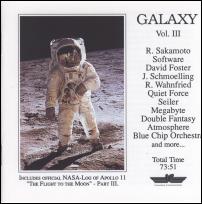
|
|
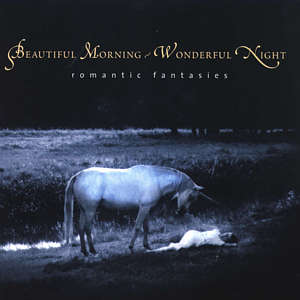
|
| is no longer available. |
available at Erdenklang |
you will find here: |
you will find here: |
is no longer available. |
you will find here: |
| MUSIC FROM UTOPIA RELOADED |

|
|
available at Erdenklang |